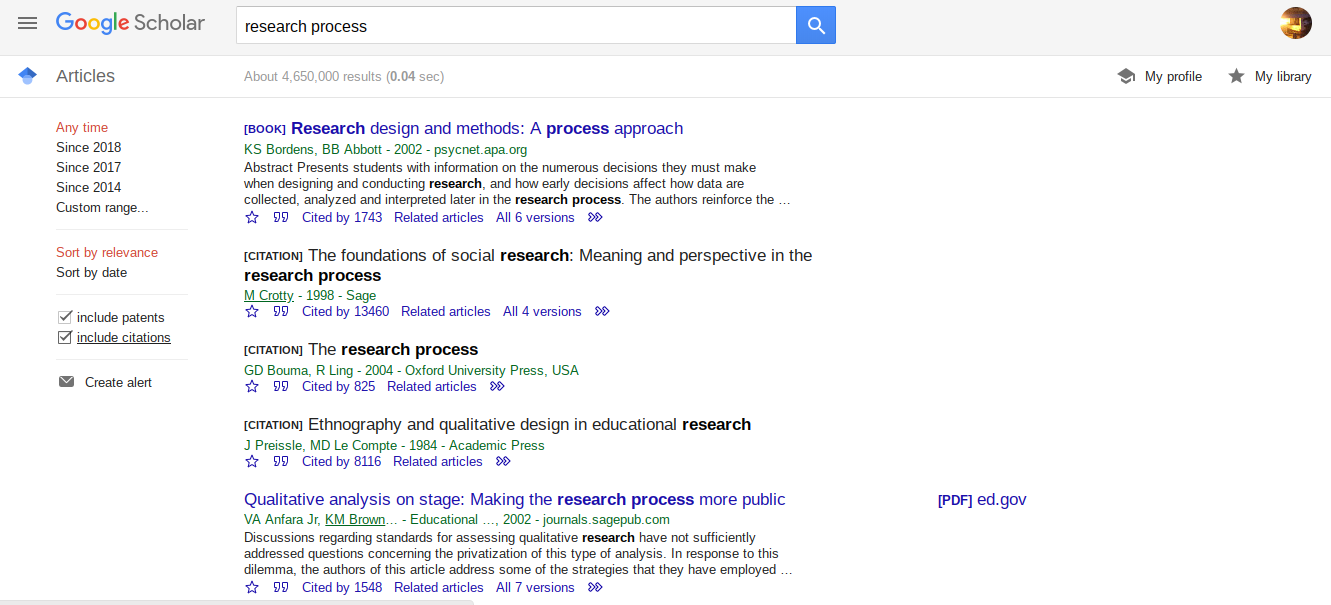4.4: Using Databases
- Page ID
- 46125
Learning Objectives
Identify tools used to find scholarly secondary sources
In the event Google or other search engines do not yield quality sources, you may find yourself requiring higher level library access. This brings us to two other areas for secondary source material:
- Google Scholar
- Library databases
Google Scholar
Google Scholar is an excellent and more refined version of Google that focuses on professional literature. While you can use Google Scholar for free, the results will likely be paywall-protected academic material, so you will need a library for access. Some public libraries offer this for free to their constituents, or if you are a faculty or student at a college or university, you also can gain immediate access to paid content. What Google Scholar can help you gather free of charge is awareness about what type of data may exist. This is important for your business report writing. If data exists, but only behind a paywall, then you may consider conducting your own primary source development (i.e, your own fieldwork such as surveys or interviews) depending on how robust your report needs to be.
For our purposes here, look at Figure 1 and compare the results of the captured search to the previous searches where we just used a standard Google search.

One of the things that Google Scholar does very well is tell you what type of source it is right away. Note how the first listing is a book published in 2002. This book is likely readily available in a library, or it could be purchased online. The sources in Figure 1 are a mix of other books and articles in professional journals.
Practice Questions
Library Databases
As mentioned above, in order to access professional journals, you will need higher-end and paywall-guarded database access. However, some institutions (particularly institutions with more academic leanings) will provide their employees with access to these. Public libraries also often have access to many databases. Databases come in all shapes and sizes and are not necessarily just troves of quantitative figures and facts. The video below describes databases, and their use:
Finding Sources From Databases
If you have access to a library database, it can be a helpful tool in finding additional sources.
Subject Headings
Most databases will include related subject headings alongside each search result. Subject headings are a form of descriptive metadata. At their simplest, they may be tags chosen by the authors, but most databases use a controlled vocabulary assigned by professional catalogers
The advantage of controlled subject terms is that they’re standardized terms that will be assigned to all appropriate content no matter what terminology (or even language) is used by the author. For example, the database Academic Search Complete uses the subject term “motion pictures,” even if the article uses the words “films,” “movies,” or “cinema.”

Whenever you find a good article in a database, check out the subject headings. If one or more of them look like matches for your topic, re-run your search using those terms—and be sure to specify you want those terms in the subject field. That will ensure the search results are really about that subject and don’t just happen to mention those words in passing somehow.
Follow the Bibliographic Links
As long as you find one good scholarly article or book, you can look up the works cited in the footnotes or bibliography to find the sources it’s based on.
You can also follow citations forward in time by looking up who cited the work you have. Web of Science has cited reference searches.
Contributors and Attributions
- Using Databases. Authored by: Freedom Learning Group. Provided by: Lumen Learning. License: CC BY: Attribution
- Screenshot of the Google Scholar search engine. Authored by: Freedom Learning Group. Provided by: Lumen Learning. License: CC BY: Attribution
- Finding Sources from Sources. Provided by: UCLA Library. Located at: http://guides.library.ucla.edu/c.php?g=180896&p=1185263. Project: Choosing and Using Library Databases. License: CC BY: Attribution
- What Are Databases and Why You Need Them. Authored by: Yavapai College Library. Located at: https://www.youtube.com/watch?v=Q2GMtIuaNzU. License: All Rights Reserved. License Terms: Standard YouTube License


